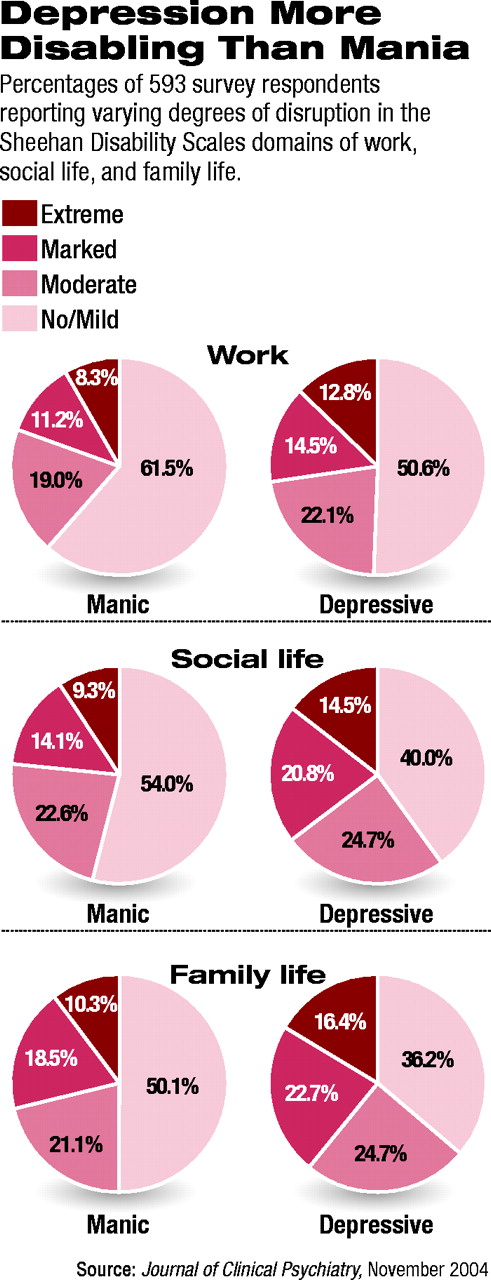In bipolar patients both manic and depressive episodes take their toll, of course, but a large new population-based study finds that the depressive phases are far more disabling on several key dimensions than are the manic phases.
Among bipolar illness patients, depressive symptoms caused more serious disruptions in occupational, family, and social functioning—findings, researchers emphasized, that point to a need for strategies that will lead to enhanced recognition and treatment of bipolar disorder.
The findings come from a study by Joseph Calabrese, M.D., of Case Western Reserve School of Medicine; Robert Hirschfeld, M.D., of the University of Texas Medical Branch at Galveston; Mark Frye, M.D., of UCLA; and Michael Reed, Ph.D., of Vedanta Research in Chapel Hill, N.C., published in the November 2004 Journal of Clinical Psychiatry.
The health information used for the analysis came from questionnaires completed in 2002 by 3,191 respondents out of a sample of 4,810, a 66 percent return rate. The survey instruments were the Sheehan Disability Scale (SDS), the Social Adjustment Scale Self-Report, the Mood Disorder Questionnaire (MDQ), and a list of other questions.
The study population was drawn from a much larger sample of Americans aged 18 and older who were representative of the U.S. population in terms of age, gender, geographic region, household size, and household income. In 2001 this sample was sent and had completed the MDQ, a self-report, bipolar screening instrument that has been validated in psychiatric outpatient settings and in samples of the general U.S. population, the researchers noted.
For the follow-up study in 2002 the researchers chose a demographically balanced sample that had screened positive for bipolar disorder based on the 2001 MDQ findings. This sample was then stratified by MDQ score and sent a survey that questioned them on “symptom frequency and symptom disruptiveness, consultation patterns, and occupational and psychosocial impacts of symptoms.”
The question eliciting symptom frequency and disruptiveness asked,“ How many days during the past four weeks did you experience hyper/energetic feelings, and on how many days were they disruptive?” Subjects were asked a similar question about “sad/down feelings.” Additional questions assessed these dimensions over the preceding 12-month period.
To determine consultation patterns, the researchers asked, in regard to both of the mood states, whether subjects had “ever consulted a physician or other health professional” and, if so, “what type of physician or health care professional.”
To assess the impact of bipolar symptoms on occupational and psychosocial functioning, the researchers had subjects complete the SDS and the Social Adjustment Scale Self-Report. The former describes symptom-related disruption of usual activities relating to work, social, life, and family responsibilities. The latter assesses the “ability to adapt to and derive satisfaction from social roles” and includes questions on work interest and performance, personal relationships, and ability to complete household chores, for example.
The data from these instruments pointed to a considerably greater disruption of work, social, and family life attributable to depressive than to manic symptoms in bipolar patients. On the SDS instrument, for example, the researchers found that 49 percent of subjects attributed “moderate or greater impairment” of work activities to their depressive symptoms, 60 percent said depressive symptoms were more disruptive of social life, and 64 percent made this attribution for family life. When they looked at the 12-month data, the researchers identified the same pattern. When they took a closer look at the work dimensions, they found that on a range of factors such as “did work poorly,” “having arguments,” and“ feeling disinterest in work,” subjects attributed significantly more of their impairment to depressive than to manic symptoms.
Depressive symptoms were also more often the motivator for someone with bipolar illness to see a physician or health care professional, the researchers pointed out. Of those who sought professional help for their symptoms, primary care clinicians were the most frequent choice, with 32 percent of subjects saying they most often consulted a primary care physician for depressive symptoms; 21 percent of respondents most often consulted a primary care physician for manic symptoms. Psychiatrists and psychologists were consulted with about equal frequency by these respondents.
Calabrese and his colleagues said that their findings in this community-based study—along with those from clinic-based studies—are of particular concern because of recent research showing“ that length of time spent depressed predicts long-term outcome in bipolar disorder.”
“These findings underscore the importance of effective prevention and treatment of depressive episodes” in people with bipolar disorder, they stated, and “suggest the historic focus, in research and in the clinic,” on treating mania in bipolar patients at the expense of depressive episodes, which cause more impairment than manic ones, “may be misguided.”
“We have numerous medications available for the treatment of mania,” Calabrese told Psychiatric News, “but very few available for the short- and long-term treatment of bipolar depression. I believe the evidence would suggest that the greatest unmet medical need in bipolar disorder is the clinical management of the depressed phase of the illness.”
Among the study limitations they noted were that “patient-friendly terms” were used to determine the extent of impairment, and responses were not verified in clinical interviews, which is the “gold standard for valid diagnoses within psychiatry.” Also, because of the study's four-week and 12-month retrospective timeframes, “results may be subject to recall bias, particularly for the data collected for the one year prior to the survey,” they said.
An abstract of the study, “Impact of Depressive Symptoms Compared With Manic Symptoms in Bipolar Disorder: Results of a U.S. Community-Based Sample,” is posted online at<www.psychiatrist.com/abstracts/200411/110407.htm>.▪

